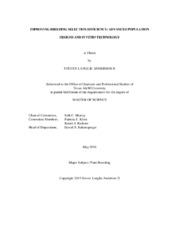| dc.description.abstract | Cultivar progression requires years of development prior to performance trials; reducing development time requirements as well as introgression of favorable alleles is crucial to the rapid improvement of cultivars. Multi-parental advance generation intercrossing (MAGIC) can provide improved genetic mapping resolution through increased allelic diversity and higher effective recombination frequencies. The Four Parent Maize (FPM; Zea mays L.) population implements a series of the strategies used in MAGIC and bi-parental populations, creating a mapping population comprised of 1,149 individuals with 118,509 markers for comparison of effects on genetic mapping resolution and accuracy of quantitative trait locus (QTL) allelic estimates. Measurements were recorded for plant height (PH), ear height (EH), days to anthesis (DTA) and silking (DTS) in seven environments spanning three years. While increasing the generations of intermating prior to selection does not increase the phenotypic distribution among the dihybrid subpopulations, it does increase the mapping resolution of QTL for EH, DTA and DTS. Using association mapping software we have identified an allele from Tx903 on chromosome 3 which decreased plant and ear height, by 4.2 and 3.7 cm, respectively. Additionally, an allele that decreases flowering time by one day was donated by Tx903 and Tx772. The detection of these QTL have previously been reported in the same region, but the allelic effect has yet to be validated. Although a single QTL was found for each quantitative trait, it is expected that many additional QTL are present; but were undiscovered due to the conservative nature of the Bonferroni multiple test correction criteria. Linkage map construction will improve estimates of the effects of multiple founders and advance generation intermating on increased effective recombination and resulting accuracy in QTL estimation and mapping resolution.
Cycling of plant cells in vitro could reduce generation times required for new cultivar development. Carrot (Daucus carota) and tobacco (Nicotiana tabacum) species were selected for their extensive tissue culture history and high tolerance toward in vitro manipulation. Isolation of parental protoplasts from cell suspensions was followed by sorting of individual cells through fluorescence activated cell sorting (FACs); expectantly allowing for production of totipotent single cell derived colonies. Supposed colonies could be designated, with marker assisted selection for further in vitro cycling or regeneration and advancement to performance trials. Demonstrating that single cells can be isolated, can divide to form cell colonies, and can be genotyped and regenerated is central to testing the proposed hypothesis of Cycling of Gametes in Vitro (CoGiV) as conceivable. This will warrant further testing towards development of procedures intended for in vitro gametogenesis induction. | en |


